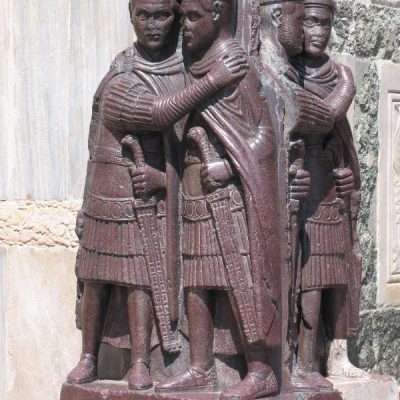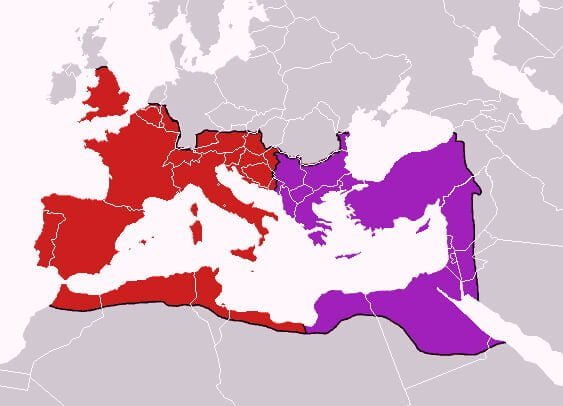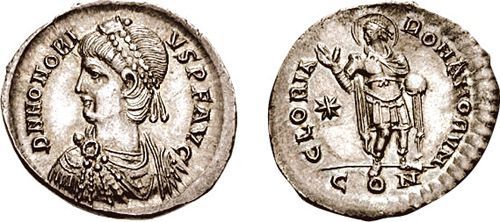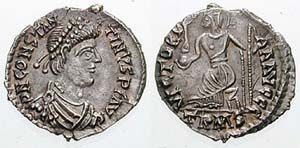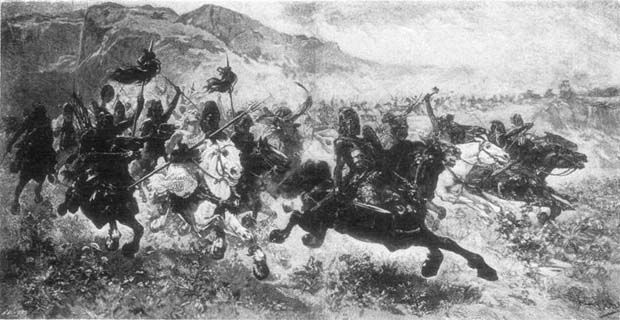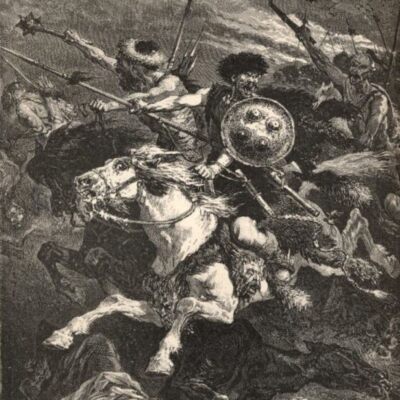Chapters
At the time of death, Theodosius, Honorius was only 12 years old. In the last days of his father’s life, he accompanied him in Milan. Minor Honorius was looked after by Stilicho, of Vandal origin, who often made himself known through his tactical and organizational talents.
In 396 CE, Stilicho wandered down the Rhine to the mouth of the river into the North Sea, making contact with local tribes along the way. After this diplomatic mission, Stilicho hurried to Greece to stop the Visigothic invasion under the leadership of Alaric. He carried out this action, at the request of the ruler of the Eastern Empire – Arcadius. After solving the problem, at the request of the same person, Stilicho had to leave the saved provinces.
The following year, 397 CE, there was a rebellion in Africa. So far obedient to Honorius – Gildon, he was in favour of Arkadius, who, without lingering long, took advantage of the offer submitted to him. But Gildon’s power did not last long. Already in 398 CE, he was removed by his brother, who soon got rid of Stilicho himself. The case of the recovery of the African diocese was over and these lands again found themselves in the zone of Honorius’s influence.
Successful news also came from another corner of the Empire, from Britain, where Namely managed to stop the attacks of Saxons, Scots and Picts.
After a short period of calm, the threat came with 401 CE. Committed to repelling Vandal attacks over the Upper Danube, the Romans could not protect all borders. This situation was eagerly used by Alaric, who in November 401 CE crossed the Alps and entered the Po valley. Honorius, terrified by this unexpected situation, hurriedly left Milan and went to the safe Ravenna, hence the headquarters of the ruler. The final clash took place on April 6, 403 CE near Police. The victorious battle for the Romans ended in a peace treaty. The aggressors left Italy and went to the Alps.
The further policy of Stilicho led in 405 CE to an open conflict between east and west. Stilicho, referring to Theodosius’ alleged last will, demanded that Arkadius return Ilyrikum. In the same year, huge masses of Goths led by Radagaisus entered the Po valley. Rome itself was within their reach. In the face of the danger weighing on the capital, Stilicho decided to take a very fatal step. He summoned the Huns and Goths for help.
In the summer of 406 CE, Radagajs began to besiege Florence. The city, which was opening to open its gates, was saved thanks to the sudden appearance of Stilicho with his allies. Radagaisus’ encircled armies surrendered. Most of the Goths were taken prisoner, but some of them were conscripted into the Roman army. The fate of Radagajs was not different from many others before him. He was beheaded at the gate in Florence.
When Stilicho was struggling with Radagajs, the Vandals and Swews pushed against the Rhine border, who were valiantly resisted by the Franks, who were in a military alliance with Rome. Increasing attacks brought results and the Franks capitulated. Hordes of barbarians have invaded the lands of Gaul. The disaster in Gaul had an adverse effect on the image of Stilicho, who was widely regarded as a traitor. Panic gripped Italy. Under her influence, the last traces of ancient faith were destroyed, including the Sibylline books.
But the problem of the Swews and Vandals was not very concerned with Stilicho, who was increasingly trying to get Ilyrikum. This led to an armed conflict between the east and west of the Roman Empire. Command in this war was entrusted to the Visigoth chief Alaric.
As if misfortune was not enough, a self-stylist appeared in Britain. Already in 406 CE, Marcus briefly lasted in Britain, then Gratian. The last of them was Flavius Constantine, also called Constantine III. In 407 CE he transferred his troops from Britain to Gaul, awaiting the trial with Stilicho. Britain, deprived of any support from Roman soldiers, proved to be easy prey for the Saxons, Scots and the English.
The arrival of Constantine was met with enthusiastic welcome by the inhabitants of the land because he decided to help the inhabitants in defence against constant attacks from the barbarians. He had some successes in the fight with them, but his army failed to repel the Swews and Vandals for the Rhine, but Constantine III had other problems – the attack of Stilicho. Constantine, anticipating the actions of Stilicho, sent his leader Saruss, who defeated Honorius’s army and occupied Provence. After this success, he appointed his elder son Constantia, who had identical success in Spain. Visigoths were not idle at that time, invading the Alps to open their way to Italy. Taking advantage of the disadvantage, they demanded huge sums as payment for the services they gave Rome in the fight in Illyria. Their request was granted.
In 408 CE died ruler of the eastern part of the Empire – Arkadius. Stilicho, using the confusion, tried to take over the successor on the eastern throne, the several-year-old Theodosius II.
In 408 CE, Stilicho decided to deal with a British usurper. But the fight did not take place, because Stilicho, became a scapegoat for the inept policy of the empire, but maybe not so much politics as the inevitable coincidence of misfortunes that caused the empire to fall more and more. Thanks to the intervention of the imperial secretary – Olympius, there were attacks in Bologna that claimed the lives of many friends of Stilicho. The news was that Emperor Honorius was also affected by the death. Stilicho decided to avenge his ruler and quickly went to Bononia, but as soon as he approached the rebel stronghold, he learned about the plot for his life. Honorius himself was the opponent of Stilicho, whose death turned out to be fiction. There was a split in Sylichon’s camp. Some of Stilicho’s friends stayed with them, but only to betray him soon. Stilicho tried to save his life by protecting himself in Ravenna, but he was tricked out of the temple, on August 22, 408 CE, he was murdered. At the news of the defeat of Stilicho, in many cities of Italy, there were bloody judgments over the Germans. Some managed to escape to Alaric.
After Stilicho’s defeat, Alaric was offended by his dismissive attitude towards him, which he met every step on the part of Honorius, broke off peace talks and attacked Italy. In autumn 408 CE, after crossing the Alps, he found himself in Italy. Visigoths who were not detained made a free march towards Rome. When they stood at the city walls, talks began again. The situation was also aggravated by hunger in the capital. The absence of the emperor caused the Senate to decide about the conditions of the truce. After many days of talks, Alaric decided to leave the area in exchange for a high price. To obtain it, it was decided to impose high taxes on the richest inhabitants of Rome. Statues and buildings that were stripped of all valuables were not spared. The conditions of the room were initially accepted by Honorius. Alaric after receiving the ransom departed to the walls of Rome and went with his army to rest in Etruria. There, his armed forces were strengthened by a group of about 40,000 slaves who, taking the opportunity, left their masters.
Honorius did not keep his word earlier, therefore Alaric decided to enforce it himself. In 409 CE he appeared again at the walls of Rome. On the inhabitants of the city, required the establishment of a new emperor, in the person of the prefect of Rome – Prysius Attalus. Alaric, in turn, became the head of the army. Then the Visigoths proceeded to ravage Italy, soon reaching the walls of Ravenna, to Honorius playing there. After all, they couldn’t get the city.
The uncomfortable situation of Honorius was further aggravated by the fact that Constantine III and his son Konstans, who had stayed in Arelate so far, got through the Alps and entered Italy. Constantine came under the pretext of wanting to help in the fight against Alaric. In fact, his motives were less noble, as he tried to jerk as much as possible for himself.
Honorius intended to escape to Constantinople, but his plans were thwarted by help from the east. Prefect Antemius sent 4,000 armed men to Ravenna, at the disposal of Honorius. When Constantine III learned of this fact, he left Italy hastily. In the Visigoth camp, there was a difference between the puppet emperor and Alaric. Priscus Attalus refused to let Alaric get to Africa on behalf of the Roman emperor and deal with the provincial governor who refused to supply grain. As a result of the conflict, Attalus ceased to be emperor in the summer of 410 CE. The upset Alaric once again stood at the walls of Rome and this time he had no intention of giving up the siege. He entered Rome on August 24, 410 CE. Terrified people sought asylum in churches that Visigoths, as Christians, left behind untouched. The plundering of Rome lasted three days. In addition to numerous loot, Honorius’s sister – Galla Placidia and Attalus were abducted from Rome. Saint Jerome, after receiving information about the capture of Rome by the Visigoths, had to say: “The light of the whole world went out.”
The Visigoths originally tried to get to Africa, but the difficulties encountered forced them to follow a different path. So they returned to Italy, which they plundered almost all year 411, and then in 412 CE, they stood in Gaul. In the meantime, Alaric died in 410. Atalauf was elected the leader.
Returning, however, to the fate of Constantine III. After 406 CE, large areas of Gaul were occupied by the Vandals, Alans and Swews, who in 409 reached Spain. Their appearance in Spain, provoked the commander of the province Gerontius, to speak against Constantine and appoint a new ruler of those lands in the person of Maximan.
Constans went against the self-proclaimed in 411 CE, but he suffered a defeat in the battle with Maximin’s army. Maxim began to hunt down the poor man and caught him in Gaul, then killed him in Vienna on the Rhone.
After Konstan’s death, Flavius Constantius appealed against Geroncjus. In this case, the authority of Constantius himself acted, to which Geroncius’s troops joined. The lonely Geroncius committed suicide, and Emperor Maxim went to the Germans east.
The stories of Maksymin and Gerontius were not lost in memory when Olympus spoke against the weakened forces of Constantine III. As you can suppose, the campaign did not pose any major problems to Olympian’s army. By coincidence, Honorius restored his control of Gaul with the eastern part of the Iberian Peninsula. Defeated Constantine III was taken prisoner, where he was soon murdered while travelling to Ravenna.
When matters were sorted out with Constantine and his sons, another self-named man appeared in Gaul, a Jovinus, supported by the Burgundians and the Alans. Constantius withdrew for the Alps, but soon, at the advice of his advisers, he decided to use the Visigoths, in exchange of whom he promised permanent settlements in this land.
Ataulf, the leader of the Visigoths, attacked Jowina in 412 CE He quickly dealt with Jowin’s brother – Sebastian, whom Jovinus made a co-ordinator, and then began to besiege Valencia, in which Jovinus took refuge. That same year, the usurper, imprisoned in Narbonne, lost his life in the spring of 413 CE by order of Honorius.
In the meantime, the conflict between Honorius and Atalauf increased. Visigoths who were not delivered the promised grain felt once again abused and did not release the hostage Galli Placydy. They decided to stay permanently around Italy. They settled in Aquitaine, as well as in the southern part of Gaul with Narbonne, but the attempt to conquer Marseille ended in failure. During the siege, Atalauf was seriously wounded. Despite his defeat, Ataulf could not easily forget his injuries from the emperor and in January 414 CE he married Galla Placidia, thinking that this marriage would improve his relationship with Honorius. He was very wrong. That same year, Honorius sent Flavius Constantius. In response, Ataulf used the services of Priscus Attalus, who was exposed to imperial purple for the second time. In the course of further struggles, Visigoths withdrew to Spain. Lonely Attalus in 415 CE was captured. Mutilated on Honorius’s order, they were taken to the Aeolian Islands.
In August 415 CE Ataulf was murdered by a slave. His successor was the son of Sigeric, whose reign was only the blink of an eye. Visigoths themselves opposed the ruler, and the new king was proclaimed Wales. Wales tried to get to Africa, which was to protect him from defeat at the hands of Flavius, but unfortunately, he did not realize his plans. Finally, a truce was established between the Visigoths and the Romans in 416 CE. In exchange for returning Galli Placidia to Honorius, Visigoths will obtain grain and become allies of Rome. In 417, Galla married Constantius Flavius, who on February 8, 421 became august, a co-ordinator in the west. But the new rule ended relatively quickly. Constantius died on September 2, 421 CE, reportedly of pneumonia. The widow of Constantius III, Galla was banished to Constantinople.
Peace with the Visigoths did not restore peace in Gaul. This time the Vandals sought their opportunity, but the Visigoths fulfilled their role as allies, eliminating the threat of another invasion. In gratitude for the protection of the land, they received gratification in the form of permission to settle in Aquitaine. In addition, Honorius exempted them from taxes, as well as being subject to Roman administration and the judiciary. After the death of Wales, Theodoric I sat on the Visigoth throne.
In the last years of Honorius’s reign, fighting in Spain with the Vandalow – Asdingami strain continued. The commander of the Roman army Castinus suffered a defeat, while the other Roman chieftain Bonifacius decided to return to Africa without dealing with the vandals for a moment. After landing in Africa, Bonifacius hastily organized the army and officially received the title of African Comes.
After Kastynus’s defeat, a wave of terror took over Spain. In cities, closed to the invader, there were often acts of cannibalism. In addition, Ostrogoths settled in Pannonia in 420 CE.
Honorius died childless on August 15, 423 CE, which allowed his nephew Theodosius II to take over the ruler of the entire Empire. Of course, this fact did not constitute any formal restitution of the empire, but merely an inspiration for further actions of the Theodosius, who did not allow the throne to take the throne by Galli’s son Placida – Valentinian. However, Theodosius II himself, whose passivity was exploited by Roman senators, was wasted. On November 20, 423 CE, the head of the secretary’s office of Honorius – John raised the imperial throne of the west.
The new emperor took a far more sensible approach, increasingly privileged, of title Christianity in ancient Rome, Christianity, especially thanks to the activities of the last emperors. He began the reform of the state by liquidating some of the apanas given to church dignitaries. One of the most important was the restoration of the jurisdiction of common courts in civil matters whose subjects of a civil law dispute were persons of the clergy.
But John’s reign had no chance of surviving the test of time. At the very beginning, Bonifatius, who came from Africa, was against Jan. He supported the efforts of Gaul Placida, thanks to which the political separateness of the West became a fact. Theodosius agreed on separateness under one condition, however, Valentinian was to be the lord of the west. Theodosius II himself offered help to obtain the throne by Valentinian, but the price for renting the army was the province of Illyricum.
The expedition against Jan set off in 424 CE by the Constantinople Army, commanded by Ardabur and his son – Aspar. Along with them, Constantinople also left Valentinian in the care of his mother – Galli Placydy.
Jan did not intend to get rid of his job, who immediately sent a message to the Huns, presided over by Aetius, to obtain military assistance from them.
In 425 CE, the Constantinople army appeared in Italy, then divided into two corps. The first commanded by Aspar, followed the mainland, while the second crossed the sea. The fleet commanded by Ardabur fell into a storm, which spared only two ships, which in addition, immediately after reaching the shore, fell into the hands of the enemy. Ardabur was transported to Ravenna, where Jan received him with full respect, but too much freedom, given to the enemy, quickly turned to John’s disadvantage. Ardabur, not controlled by anyone, began widespread agitation, convincing Jan’s officers of the nonsense of their resistance to Valentinian’s claims.
In the meantime, Aspar made it through the Alps without major problems and began the siege of Ravenna, behind which Jan hid. But at this point, information about the alleged death of her father could have reversed the fate of the state, because Aspar even intended to return home. The situation was saved only by a guide who led the eastern army to the centre of Ravenna. John, who had been left by all previous supporters, was transported to Aquileia, where, on Galli’s order, his right arm was cut off, then he was put on a donkey and transported around the city. Then his head was chopped off. The execution was carried out at the turn of May and June 425 CE
Aetius, arrived only after John’s death, leading with him an army of 60,000 Huns. Soon there was a clash with Aspar, occupied by thousands of lives. Eventually, it was decided to make an agreement, and the Huns left the empire for adequate compensation.
Valentinian’s reign began extremely bad for non-Christian worshipers. As early as in 426 CE, the emperor issued two laws. The first was only a repetition of earlier rights, which confirmed the annulment of wills made by apostates. The second one forbade Jews and Samaritans to ignore those children who decided to change their faith to Christianity. But the real power in Rome, in place of the six-year-old emperor, was exercised by Aetius, Bonifacius and Felix. As early as around 430 CE, Felix was assassinated. Most likely Felix tried to get rid of Aetius, but his action was prejudiced. Felix and his wife died at the hands of Aetius’s henchmen. Aetius became the head of the army, who immediately went to the upper Danube, where he stopped the Juthungi’s beds inside the Empire.
“Since there the cheeks of the children are deeply furrowed with the stee from their very birth, in order that the growth of hair, when it appears at the proper time, may be checked by the wrinkled scars, they grow old without beards and without any beauty, like eunuchs. They all have compact, strong limbs and thick necks, and are so monstrously ugly and misshapen, that one might take them for two-legged beasts or for the stumps, rough-hewn into images, that are used in putting sides to bridges. But although they have the form of men, however ugly, they are so hardy in their mode of life that they have no need of fire nor of savoury food, but eat the roots of wild plants and the half-raw flesh of any kind of animal whatever, which they put between their thighs and the backs of their horses, and thus warm it a little.”
A little earlier, because in 427 CE problems with Bonifacius began. Bonifacius felt threatened by Aetius’ actions and therefore proceeded to fortify his possessions in Africa. Soon an order came, releasing Bonifacius from further service. As you can suppose, Bonifatius did not follow the recommendations of the Ravens court. Three commanders sent against him were killed.
In Ravenna, despite the apparent failure of the action, continued to fight Bonifacius. The next year a new province governor was appointed. It was also then that Bonifacius began looking for allies. In order to save himself from the military activities of the new province governor, as well as the nomads’ deaths inside the province, he decided to form an alliance with the Vandals, who were currently in Vandalusia (today’s Andalusia). Following the agreement in 429 CE, 80,000 Vandals, led by Gaiseric, landed in the property of Bonifacius.
At the news of the Vandal crossing, the policy towards the governor to Africa changed in Ravenna. Instead of dismissing Bonifacius, he was asked to get rid of the guests he invited. Compliance with the entrusted task ended in defeat. Bonifacius with a small group of survivors managed to get to Hippo. Shortly after, Vandals appeared under the city walls, entering the siege of the city. In the meantime, Bonifacius, with a group of devoted friends, got out of the city and headed towards Carthage. Soon the Vandals came here as well. For help, troops were sent by Theodosius II, but also they, led by Aspar, suffered defeat in the fight against the barbarians.
The reward for the loss of Africa was the command of both categories of troops, which were entrusted to Bonifatius in 432 CE. There was soon conflict with Aetius, which ended with another fratricidal struggle at Ariminium. Aetius, this time defeated, escaped to the Huns, but Bonifacius, wounded during the fighting, did not survive the competition, who soon died.
The following year, at the head of the Huns, Aetius entered Italy. The Emperor had nothing else to do but to return Aetius to favours. In gratitude for the intervention, the Huns received Valeria and Panonia the Second. Aetius’s exaltation in 435 CE resulted in an alliance with the Vandals. Vandals became allies of Rome. In exchange for withdrawing from the African provinces, they received the lands of Mauritania and Numidia. After the emperor, they were obliged to put their own people to help Rome and to pay tribute.
In the years 435-436 CE, Aetius fought in Gaul. Together with the Hunami accompanying him, he dealt with further attacks from the Franks and Vandals. As if that was not enough, new rebellions initiated by the poor people of the province appeared.
After the alliance with the Vandals, the subsequent years of the reign of Valentinian III passed fairly quietly, not counting the campaign of Aetius. The situation changed only in October 439, when the Vandals won Carthage. The truce turned out to be a short-term tool for maintaining peace in Africa. Barbarians resumed plundering proconsular Africa. After taking over the fleet in the Carthaginian port, Geyser was preparing for the Sicilian attack, which, moreover, took place the following year. Unable to capture the Sicilian cities, however, the Vandals limited themselves to looting in the coastal belt. To Valentinian’s help came reinforcements from Constantinople, which instead of guarding the border on the island, proceeded to loot the island again. However, the activities quickly ceased, as the Huns invaded the Balkan provinces. Lonely in battle, Valentinian began peace talks in 442 CE. He eventually decided to surrender the African Vandals (Tripoli and proconsular Africa), for which he regained Numidia and Mauritania.
In the meantime, quite a different situation appeared in Gaul, where Aetius successfully fought. The Roman commander stopped the Franks, in addition, he managed at some points to lean the border of the empire again on the Rhine. By treating the defeated Burgundians with dignity, he obtained a very important ally in further battles with the barbarians.
Fighting against invaders also continued in Spain. Once again, it was struggling with Swewami and Vandals. The peasants who tried to revolt against the authorities also gave it up.
A serious misunderstanding occurred in 449 CE. This time the conflict turned out to be Attila, chief of the Huns and Valentinian III, however, the inspiration for the course of events was the emperor’s sister – Honoria. Honoria promised to one of the Roman dignitaries, did not want to agree to such a future, therefore she decided to look to Attila. Sending a trusted servant to the Huns, she handed him the ring he was to show Attila as proof of power of attorney. And this very small object soon became a source of misunderstanding. Well, Attila, accepted him as a marriage proposal and decided to take the opportunity. He demanded from Valentinian III the release of his future wife and appropriate dowry, in the form of half of the empire. As you might expect, Attila’s request enraged Valentinian, who intended, for example, to punish his sister, including the death penalty. Eventually, Honoria married senator Heraclius, whom she promised. In addition, she was sent to Constantinople, but Attila persisted and repeated his demands. Finally, in 451 CE, he set out against the Romans. He attacked Gaul along with his people. Until now, nobody took Attila’s threats seriously, so it can be assumed that the surprise was enormous. Against the Huns, Aetius set out with a hurriedly gathered army. His plan was to acquire Visigoths once again. The mission, which ended in establishing a defence alliance, was entrusted to Eparchius Avitus.
In the meantime, Attila went deeper into the country. Around May 451 CE he reached Cenabum Aureliani(Orleans), whose inhabitants resisted the invaders valiantly for over a month. In mid-June, they decided to capitulate but suddenly appeared on the horizon rushing to the rescue, troops Visigoths and Romans. The Huns found it difficult to get out of the city and take safe positions in a place called Catalan Fields (Campi Catalauni). Soon there was a great battle, which lasted until late at night. Despite this, the Romans succeeded. On the battlefield, the Visigoth king Theodoricfell, and his son Torismund succeeded him. Expected the next day the clash with the Huns did not take place. The Visigoths returned home, and Attila quietly left Gaul, which Aetius allowed him.
The following year, Attila returned to Italy. Without encountering resistance, he wreaked much havoc. Among the many cities that suffered damage was also Aquileia, whose inhabitants founded a new settlement – Venice. Then the chief of Hunów began his march on Rome. Valentinian, encouraged by Aetius, did not decide to leave the city or Italy. As if that was not enough, information came that part of the Danube provinces had become the prey of the Eastern Empire. Rome was saved by an epidemic that wreaked havoc on the Huns.
In 453 CE, suddenly died Attila. The aftermath of the death of the Hun chief was the sudden disintegration of the tribes that were previously united, the authority of the great ruler. Most of the Huns headed east, while few other tribes settled on the lower Danube. There was also an internal war between the tribes themselves.
In the same year, the brothers murdered Torysmund, trying to strengthen the kingdom at the expense of Roman possessions. He was replaced by Theodoric II, who renewed his alliance with the Romans while supporting them in their fight against Swewami in Spain.
The next year brought another victim. On September 22, 454 CE, after a sharp exchange of words, Valentinian III attacked Aetius and cut him with a knife. The killer survived him by only a few months. During a review of the forces of Mars, made on March 16, 455 CE, two friends of Aetius, attacked Valentinian III.
Thank you after the murder of Valentinian, it was decided to choose a new ruler – senator Petronius Maximus. From the beginning, both senators and the army looked unfavourably at the person of the new ruler. To legitimize his rule, he decided to marry his widow, Valentinian, Eudoxia. This act certainly did not win him popularity among the social groups mentioned earlier. He decided to marry his son Palladius, Eudokia’s daughter Eudokia, but unfortunately, the woman was already promised to Huneryk – the son of Genzeryk. To protect himself against the inevitable actions of Gaiseric, he sent Avitus to the king of the Visigoths. Despite the success of the mission, it turned out to be delayed, since Genzeryk was already in Italy in 455 CE. The capital city’s hasty evacuation began. Emperor Petronius was also among the group of refugees, who travelled in the style of incognito. Unfortunately, unfortunately, he was recognized and torn apart by the capital’s people dissatisfied with his actions. The emperor died May 31, 455 CE.
Vandals appeared in Rome on June 2, 455 CE. Over the next 14 days, barbarians plundered the capital from its wealth. Gaiseric welcomed the bishop of Rome – Leon, who obtained that the plundering of Rome would take place inhumane conditions. Eudoxia and her two daughters were also abducted from Rome and sent to Carthage.
After calming down the emotions and shaking off another defeat, the problem of “empty throne” arose. The new emperor unofficially anointed the Visigoth king Theodoric II. It was Avitus. The reign of Avitus did not begin until July 9, 455 CE, when Avitus accepted the army. In the meantime, Avitus was sending messages to Constantinople, which were to force or rather plead for recognition of Avitus’s rule by the Eastern court. Despite castling at the helm of the state, the situation in the Western Empire did not improve. There was news of the planned invasion of Gaiseric in Sicily and Italy, but Avitus damaged these plans by sending Rycymer, who managed to defeat Genzeric in two battles fought in 456 CE
After the apparent win, another problem appeared. The shortage of food in the city forced the emperor to part with the Visigoths who had accompanied him from Italy since the beginning of his reign. After all, they demanded a fee for their services. To satisfy their demands, monuments and sculptures still survived in Rome to get rid of unnecessary guests. But the emperor did not do well. After he got rid of his “guardians”, the opposition against the actions of the emperor appeared gracefully. In the summer of 456 CE, he went to Gaul.
Vacancy in the capital decided to use Rycymer, which gave purple Majorian. Usurpation, however, was not a great excuse for Avitus to come to Rome, only after the death of his friend, oblivious to the Visigoth’s preparations being prepared, engaged in the fight with Swewami in Spain, Avitus decided to move to Italy. An ill-considered step was the reason for his fall. On October 17, 456 CE, Avitus suffered a defeat near Placencia. The price for preserving his life was the post of bishop of Placencia and his renunciation of the throne.
After the abdication, the actual ruler of the western part of the empire was Ricimer. It was not until April 457 CE that he proclaimed Major Emperor.
In the meantime, new battles against barbarian aggressors continued. The Majorian was successful in the fight against the Alamans, who tried to break the border around the middle Danube, as well as with the Vandals exploring Italy.
In the meantime, the unhappy news came from Gaul, where no one wanted to recognize Majorian as the new ruler. In addition, the south of Gaul fell prey to Franks and Visigoths. The Burgundians also came under Lugdunum.
Majorian set off towards Gaul, only in the fall of 458 CE. He quickly regained Lugdunum, and then started to help the endangered Arelate. During his activities in Gaul, he communicated with the Visigoth King Theodoric II, who, once again, took on the responsibility of fighting Swewami in Spain.
In the summer of 460 CE, the Majorian set off on a journey to the land of Vandals, who, surprised by the actions of Majorian, tried to make peace, but the initiative met with definite contempt on the part of the emperor. And at that moment fate turned around. Through negotiations, the Vandals obtained Tripoli, as well as the Balearic Islands, Sardinia and Corsica. Gaiseric only committed himself not to attack Italy and Sicily.
The following year, the Majorian tried again to face Gaiseric, but his plans were thwarted by Rycymer, who in Dertona forced Majorian to abdicate on August 2, 461 CE after five days of torture, the Majorian was murdered.
Once again, Rycymer took power. His will on November 19, 461 CE made Libius Severus the new ruler. As before, the Eastern emperor Leon did not accept this candidacy. To top it off, Marcellinus also stood up against Libius in Dalmatia, and he recognized only the emperor of the east – Leon, as the only superior. The situation repeated itself in Gaul, where Egidius decided to enter Italy to deal with Libius and Knight. At the right moment, however, reacted Rycymer, who stirred up against Egidius Visigoth and Burgundy. Egidius in the battle of Orleans defeated the Visigoths, from that time on constituting an even greater threat to the rule of Knight and Libius. Their position was further aggravated by the fact that around 463, Egidius sent a message to Gaiseric to form an alliance whose blade would be directed against Rycymer and Libius. Preparations for the invasion were interrupted by the sudden death of Aegidius in 464 CE
After Aegidius, Paul took power in Gaul, who continued the policy of his predecessor hostile to Libius. To weaken the Visigoths, he decided on an alliance with the Franks. In a sense, Paweł’s doing so was dictated by the increasingly bold invasion of the Saxons on the lands of Gaul.
On November 14, 465 CE, Libius suddenly died. Suspicions of the criminal cause of death fell on Rycymer, but he did not face any consequences of this act.
In the years 465-467 CE, the emperor of the east became Leon. The vacancy on the throne ceased to exist until April 12, 467, when Antemiusbecame the emperor, the choice resulting from the agreement that had emerged between Knight and Leon.
The new ruler was headed for the capital at the head of a powerful army that was to be used to finally solve the problem of Vandals. After joining the lands of the Eastern Empire, Anthemius did not hesitate in fulfilling his commitment. The fight against Vandals has begun. The Eastern Empire’s land army seized the coast of Libya and Sardinia. And at that moment the stairs began, because sent by Leon, his brother-in-law – Basilica, too much believed in the agreeableness of Gaiseric. At that time, the Vandal chief seized most of the Constantinople ships.
The situation in Gaul was also getting worse. There, the Visigoth king Euryk, who sat on the throne after the death of Theodoric II in 466, attacked Roman possessions. Actions were stopped by Paweł, but he soon died during the struggle with the Saxons. After his death, Gaul was ruled by Sygarius, son of Egidius, but the country he chose was already cut off from the empire, surrounded by Brugunds and Visigoths. In this situation, in 470 nene Anthemius sent a powerful army there, commanded by his son – Antemiolus. During the slaughter, because in other words you cannot describe what happened to the Roman army over the Rhone, Antemiolus also fell. Almost all Galia fell into the hands of the Visigoths. Only small enclaves with a different political orientation remained.
Anthemius’ constant defeats undermined his authority and support of Rycymer, as a result of which a conspiracy was established for the emperor’s life, but fortunately, it was discovered in time. In addition, in April 472, a new usurper appeared in the person of Senator Anicius Olibrius. He was initially sent from Constantinople for a mediation mission, but while already in Italy, he turned purple himself. On the other hand, his position could not save anything anymore, because Rycymer went against Anthemius with the Burgundians accompanying him, commanded by Gundobad. The Ostrogoths, led by Vidimer, started to help Anthemius, but Rycymer quickly overwhelmed them in a battle near Hadrian’s Mausoleum. The emperor tried to escape in the guise of a beggar but caught, he died on July 11, 472 CE at the hands of Gundobad.
Shortly after the victory over Anthemius, because August 18 Rycymer died of a heart attack. Soon after him, on November 2, Olibrius also died. From then on, was ruled by Gundobad, as there was no official successor on the throne. It was not until March 3, 473 CE, that a new ruler appeared in Ravenna Glicerius, a puppet in the hands of Gundobad. Soon, Glicerius remained alone, for the Burgundy chief had to set out for Gaul to fight for the throne of the late King Gundevid. To make matters worse, the Emperor of the East, Leon, did not recognize Glicerius and supported the candidacy of Julius Nepos. Julius Nepos became emperor on June 19 or 24, 474 CE. From the very beginning, Visigoths set off against Nepos, but their expedition was crushed by Nepos. Then the emperor tried to help some resistance points in Gaul, but the lack of facilities prevented him from acting. In 475 CE He decided to make peace with the Visigoths.
In the early 475 CE, Orestes, the head of the army, came to the political arena and soon took over full power in the state. Initially, at the request of Nepos, preparations were made for the war with the Visigoths, but Orestes, instead of attacking the enemy, decided to take a different path. He decided to get rid of Nepos, but he fled to Dalmatia at the end of August 475. It wasn’t until September of the same that he brought his five-year-old son Romulus Augustus to the Roman throne. In the name of the emperor, the perversity of times was hidden. The last emperor was named after the first king of Rome and the name of the creator of the principate – Augustus.
Over time, the name was changed to a bit more contemptuous. Romulus was replaced by Momyllus and Augustus by Augustulus. Through his son, Orestes had only Italy and part of the Alpine provinces.
During the last year of the Western Empire, no memorable deeds have happened. Soon a new danger appeared. He was heading for Rome at the head of the Germans Odoacer, who in the battle of Ticinium defeated Orestes. In August, Orestes was murdered. Then Odoakr captured Ravenna and forced Romulus to abdicate on September 4, 476 CE, and sent the insignia of the imperial authorities to Constantinople – Emperor Zenon. In this way, it was declared that the West would no longer need a separate emperor – a representative from Constantinople was to be a representative for the entire Empire. Emperor Zeno recognized Odoakra as a patrician of the West. In the eyes of Constantinople, Julius Nepos, whom his own generalissimo Orest banished from the country, remained the legal emperor of the West.
After the death of Nepos in 480 CE, Zeno, recognizing Odoakr as the patrician of the West, gave Odoakr the right to nominate the West consul: in 480 CE, Basil was appointed to assist Odoakr in the Roman synod of Felix III as Pope. Basil was entitled eminnentissimus vir praefectus atque patricius – representing Odoakra, which was entitled praecellentissimus rex Odoacer. So instead of the terrible end of the Western Empire agonizing under the barbarian hordes, we can state the official restoration of unity of the Roman Empire, which ceased to have separate emperors. However, the reality was different. Rome was irretrievably lost.
Last Roman
It is a colloquial term used in historical journalism to describe a character who is considered the last representative of ancient culture and ancient Roman virtues in the face of the end of the age and progressive barbarization. The term comes from the work of Cremutius Cordius, a Roman historian, who, as an advocate of the republican system, called “the last Romans” (ultimus Romanorum) Marcus Brutus and Cassius – killers of Julius Caesar.
The “Last Roman” was called, among others:
- Aetius (390-454 CE) – a Roman leader who defeated Huns in 451 CE in the Catalaunian Fields he achieved the last great victory in the history of the Roman arms,
- Majorian (420-461 CE) – the West Roman emperor in 457-461 CE, the last ruler who tried to save the power of the West and oppose barbarians militarily,
- Ambrosius Aurelianus (mid-fifth century) – the Roman commander who around 450 CE picked up the Celtic population of Britain to fight against Saxon invaders,
- Syagrius (430-486 / 487 CE) – the last Roman governor of Gaul, who managed to maintain sovereign power over her several years after the fall of the Western Roman Empire,
or later:
- Boethius (480-524 CE) – a Christian philosopher and theologian, considered the last representative of classical philosophy,
- Cassiododor (483-583 CE) – a Latin writer at the court of the Ostrog kings, caring for the preservation of ancient literary traditions,
- Justinian I (483-565 CE) – Byzantine emperor in the years 527-565 CE, who made the goal of his reign to regain the former lands of the Roman Empire,
- Belisarius (505-565 CE) – Byzantine commander who recovered northern Africa from the hands of Vandals and defeated Ostrogoths in Italy,
- Gregory the Great (540-604 CE) – Pope in the years 590-604 CE, reformer of the Western Church.

